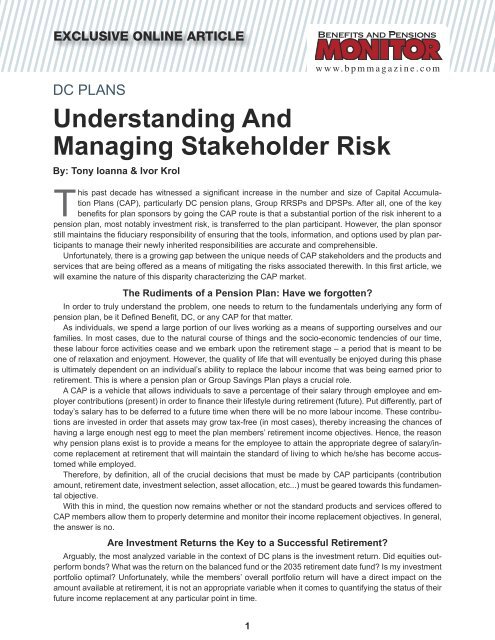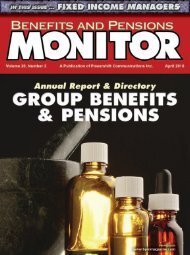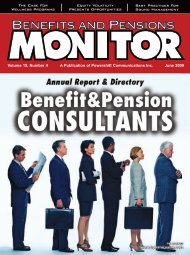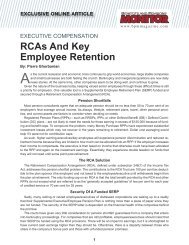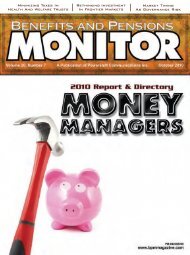Tony Ioanna & Ivor Krol - Benefits and Pensions Monitor
Tony Ioanna & Ivor Krol - Benefits and Pensions Monitor
Tony Ioanna & Ivor Krol - Benefits and Pensions Monitor
- No tags were found...
Create successful ePaper yourself
Turn your PDF publications into a flip-book with our unique Google optimized e-Paper software.
EXCLUSIVE ONLINE ARTICLEw w w. b p m m a g a z i n e . c o mDC PLANSUnderst<strong>and</strong>ing AndManaging Stakeholder RiskBy: <strong>Tony</strong> <strong>Ioanna</strong> & <strong>Ivor</strong> <strong>Krol</strong>This past decade has witnessed a signifi cant increase in the number <strong>and</strong> size of Capital AccumulationPlans (CAP), particularly DC pension plans, Group RRSPs <strong>and</strong> DPSPs. After all, one of the keybenefi ts for plan sponsors by going the CAP route is that a substantial portion of the risk inherent to apension plan, most notably investment risk, is transferred to the plan participant. However, the plan sponsorstill maintains the fi duciary responsibility of ensuring that the tools, information, <strong>and</strong> options used by plan participantsto manage their newly inherited responsibilities are accurate <strong>and</strong> comprehensible.Unfortunately, there is a growing gap between the unique needs of CAP stakeholders <strong>and</strong> the products <strong>and</strong>services that are being offered as a means of mitigating the risks associated therewith. In this fi rst article, wewill examine the nature of this disparity characterizing the CAP market.The Rudiments of a Pension Plan: Have we forgotten?In order to truly underst<strong>and</strong> the problem, one needs to return to the fundamentals underlying any form ofpension plan, be it Defi ned Benefi t, DC, or any CAP for that matter.As individuals, we spend a large portion of our lives working as a means of supporting ourselves <strong>and</strong> ourfamilies. In most cases, due to the natural course of things <strong>and</strong> the socio-economic tendencies of our time,these labour force activities cease <strong>and</strong> we embark upon the retirement stage – a period that is meant to beone of relaxation <strong>and</strong> enjoyment. However, the quality of life that will eventually be enjoyed during this phaseis ultimately dependent on an individual’s ability to replace the labour income that was being earned prior toretirement. This is where a pension plan or Group Savings Plan plays a crucial role.A CAP is a vehicle that allows individuals to save a percentage of their salary through employee <strong>and</strong> employercontributions (present) in order to fi nance their lifestyle during retirement (future). Put differently, part oftoday’s salary has to be deferred to a future time when there will be no more labour income. These contributionsare invested in order that assets may grow tax-free (in most cases), thereby increasing the chances ofhaving a large enough nest egg to meet the plan members’ retirement income objectives. Hence, the reasonwhy pension plans exist is to provide a means for the employee to attain the appropriate degree of salary/incomereplacement at retirement that will maintain the st<strong>and</strong>ard of living to which he/she has become accustomedwhile employed.Therefore, by defi nition, all of the crucial decisions that must be made by CAP participants (contributionamount, retirement date, investment selection, asset allocation, etc...) must be geared towards this fundamentalobjective.With this in mind, the question now remains whether or not the st<strong>and</strong>ard products <strong>and</strong> services offered toCAP members allow them to properly determine <strong>and</strong> monitor their income replacement objectives. In general,the answer is no.Are Investment Returns the Key to a Successful Retirement?Arguably, the most analyzed variable in the context of DC plans is the investment return. Did equities outperformbonds? What was the return on the balanced fund or the 2035 retirement date fund? Is my investmentportfolio optimal? Unfortunately, while the members’ overall portfolio return will have a direct impact on theamount available at retirement, it is not an appropriate variable when it comes to quantifying the status of theirfuture income replacement at any particular point in time.1
For example, let us assume that a balanced fund realized a loss of 15 per cent in 2008 <strong>and</strong> that two individualshad their plan assets invested in this fund. Let us further suppose that the first individual has threeyears of plan participation <strong>and</strong> has accumulated $10,000 in assets <strong>and</strong> the other individual has 30 years ofparticipation <strong>and</strong> has accumulated $500,000 in assets.While both individuals lost the same percentage of their total plan assets, the impact on their future ability togenerate an adequate retirement income is completely different. The younger member can more easily absorbthe 2008 investment loss because many years of future contributions remain <strong>and</strong> the account value is small;the older member unfortunately has neither the luxury of time nor many years of contributions remaining tomake up the losses. In this example, the action required by both individuals in order to ensure that they arestill ‘on-track’ with their retirement objectives is quite different <strong>and</strong>, unfortunately, cannot be properly assessedby analysing investment returns.Bad or Lacking Information Leads to Wrong DecisionsAs previously mentioned, it is the plan member who bears the majority of the risk in a CAP <strong>and</strong> who is ultimatelyresponsible for the key decisions. Therefore, it is only natural that specific tools <strong>and</strong> information arerequired in order to assist the member in carrying out these responsibilities in a confident <strong>and</strong> informed manner.Since the objective of the CAP is to provide an adequate income at retirement, then what the membersreally need is a way of measuring the impact of their decisions today on their potential retirement income oftomorrow.During a June 2009 hearing on ‘Examining Target Date Funds’ carried out jointly by the Securities ExchangeCommission (SEC) <strong>and</strong> Department of Labour (DOL) in the United States, one of the key conclusionswas that the plan participant’s contribution rate is the most crucial element in achieving a “successful retirement.”Unfortunately, the most recent <strong>Benefits</strong> Canada CAP Member Survey found that only 40 per cent ofrespondents had an excellent or very good underst<strong>and</strong>ing of the contribution amount required in order to retirewith enough money to fund their desired lifestyle. This finding is not surprising when one considers the type ofinformation that CAP members are generally given to work with, as well as the manner in which it is presented.A member cannot make alterations to their funding <strong>and</strong> investment strategy in a truly informed fashion if theyhave no way of measuring the impact of these changes on their potential retirement welfare.A CAP member’s greatest risk is the risk that he/she does not yet know! The fact that plan members onlyenrol once in their company retirement program means that they rarely retain essential information regardingthe key aspects of their plan <strong>and</strong> often forget how to stay on-top of their retirement planning. This is why theeducation, information <strong>and</strong> tools that CAP sponsors provide to their plan members are extremely important<strong>and</strong> must help them make the right decision, not hinder their comprehension <strong>and</strong> engagement.In the second instalment of this three part series, we will examine what can theoretically be done in order toalign the information that plan participants receive with their need to ensure that they are ‘on-track’ with theirretirement income objectives.(Part I of III)<strong>Tony</strong> <strong>Ioanna</strong> is vice-president, DC practice, eastern region, <strong>and</strong> <strong>Ivor</strong> <strong>Krol</strong> is an analyst, financial riskconsulting, with Aon Consulting.2


